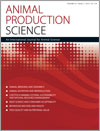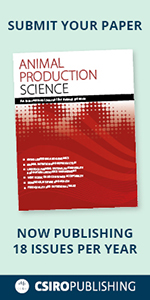
Animal Production Science
Volume 53 Number 2 2013
AN12162Male traits and herd reproductive capability in tropical beef cattle. 1. Experimental design and animal measures
Tropical beef cattle herd reproductive performance could be improved if traits in males could be identified that were genetically related to female reproductive traits. The development of an appropriate breeding program design and evaluation of novel traits was required to allow the identification of early-in-life predictors of male fertility to enable selection for improved female reproductive performance. The knowledge gained from this study will assist in the genetic improvement of male fertility traits associated with female fertility traits to increase herd profitability.
AN12163Male traits and herd reproductive capability in tropical beef cattle. 2. Genetic parameters of bull traits
Improving reproduction in cattle herds could be made more efficient if the genetic merit for fertility in young replacement bulls was known. Knowledge of the genetics of reproductive capability of young bulls is limited but details of heritability and genetic correlations among some novel and traditional measures given here suggest that selection to improve fertility traits is possible and not antagonistic to other production traits. Some of the attributes measured have value as selection criteria but further work is needed to test their genetic association with female lifetime reproductive performance.
AN12166The effect of manipulation of pellet size (diameter and length) on pellet quality and performance, apparent metabolisable energy and ileal nutrient digestibility in broilers fed maize-based diets
The importance of pellet quality in improving broiler performance is well recognised. This study examined the effect of pellet diameter and length on pellet quality, and showed that manipulation of pellet size can be considered as a potential strategy to improve pellet quality. This approach can be used to manufacture highly digestible high quality pellets at low conditioning temperatures.
AN12148Alkaline hydrolysis of porcine blood haemoglobin: applications for peptide and amino acid production
The transformation of whole proteins, which are usually wasted, into valuable peptides can be achieved by alkaline hydrolysis. The reagents employed are cheap and easy to obtain and the process control is very simple. Large amounts of protein can be processed, thereby producing affordable peptides and amino acids that can be added to animal food (for fish, cattle or pets) in order to increase digestibility and protein intake.
AN12154Genetic variation in fatty acid composition of subcutaneous fat in cattle
The fatty acid composition of beef fat has been linked to flavour and consumer health. Our research demonstrated that all major individual fatty acids were moderately to highly heritable and genetically related to overall fatness. These results indicate that selective breeding could be used to change the composition of beef fat.
AN11320Effects of the correction of particle microbial contamination and particle transit model in the rumen on in situ protein evaluation of grass hays
The determination of nitrogen efficiency in ruminants needs accurate feed protein evaluation. Ruminal comminution rate and microbial contamination of particles shows low intestinal digestible protein contents in grass hays, which are largely overestimated nowadays. Therefore, rationing systems should consider that their protein value is mainly determined by the microbial protein synthesised from ruminal fermentation.
AN12123Effect of copper source on phytase stability in the premix of weanling piglets
Tribasic copper chloride (TBCC) is a less reactive and destructive form of copper relative to copper sulfate in piglet diets. The present study aimed to investigate the effect of TBCC on phytase stability in the premixes of weanling piglets at different storage temperatures compared with copper sulfate. The results of the study indicate that TBCC could maintain the stability of phytase in the piglet premix much more effectively than copper sulfate regardless of temperature and storage duration.
AN12067Effects of low protein diets on growth performance, carcass traits and ammonia emission of barrows and gilts
The protein of commercial diets is reduced by 10 and 20 g/kg in order to reduce nitrogen excretion in manure. We found that a reduction in CP of 10 g/kg with amino acid supplementation reduces NH3 emission by 19.9% without affecting the performance or carcass characteristics. However, reductions in dietary CP of 20 g/kg reduce NH3 emission but impair the carcass traits.
AN12070The allometric relationship between clean mohair growth and the fleece-free liveweight of Angora goats is affected by liveweight change
Clean fleece weight is affected by liveweight and change in liveweight in Merino sheep, Angora and cashmere goats. However, how these relationships progress as animals age has not been elucidated. A restricted maximum likelihood model was developed for clean fleece weight after log10 transformation, which allowed the observations of the same animal at different ages to be correlated in an unstructured manner.
AN12117Beef cattle keeping by smallholders in a mountainous province of northern Vietnam in relation to poverty status, community remoteness and ethnicity
Can small-holder beef production reduce poverty in the highlands of Vietnam? This study found that there are more advantages to wealthier farmers in keeping beef cattle for income generation than poor farmers. Only in the identified advantageous beef regions with appropriate policies could the development of beef production contribute to poverty reduction.
AN12108Reproductive and productive performances of the stress-negative Piétrain pigs in the tropics: the case of Vietnam
The reproduction and production performance of Piétrain pigs resistant to stress was studied in the tropical climate of Vietnam. The reproduction and production performance were reduced due to the adaptation to tropical climate, whereas the adaptation did not influence lean meat percentage. An experiment should be conducted to investigate the possibility of using these pigs in Vietnam as terminal boars to improve meat percentage as well as a genetic resource for the production of hybrid boars.



